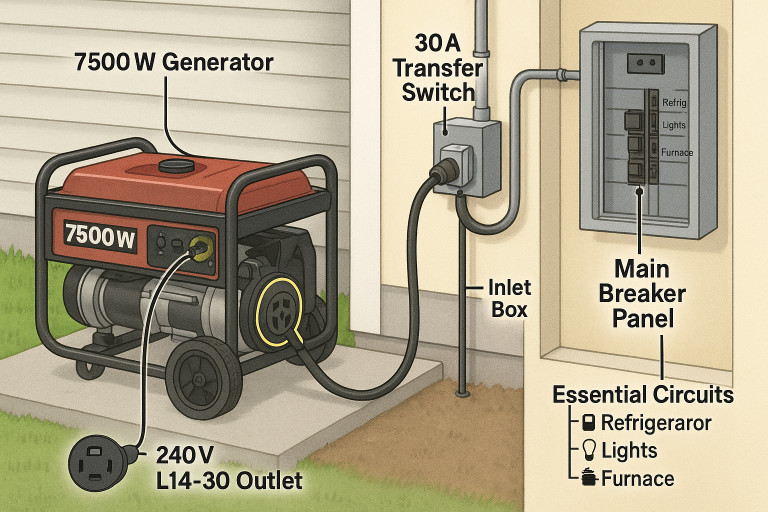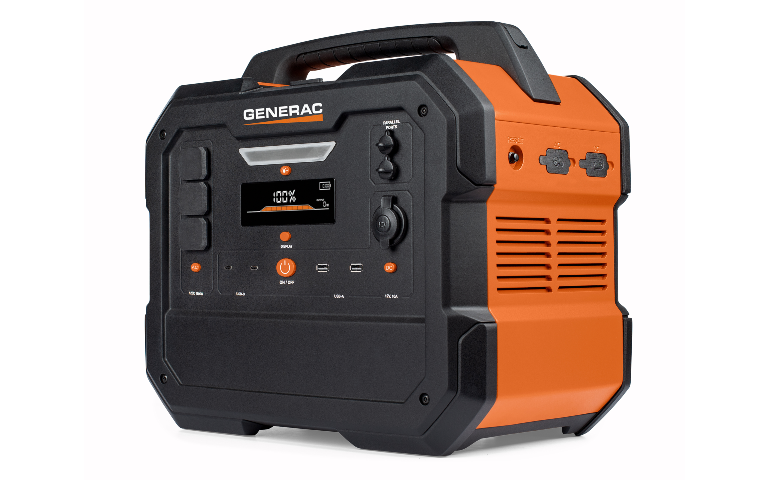Can I Use my Portable Generator to Power my Sump Pump?
As someone who’s been in both power outage and flooded basement situations, I understand the need for a backup power source for your sump pump.
Can I use my portable generator to power my sump pump? In this article, I’ll guide you through the necessary steps and precautions to safely use your generator for this purpose.
We’ll cover power needs, grounding, extension cord selection, safety guidelines, fuel monitoring, and more.
Get ready to confidently utilize your generator to protect your home during emergencies.
Key Takeaways
- Ensure the generator has sufficient power for the sump pump wattage.
- Properly ground the generator and use an outdoor-rated extension cord.
- Follow safety guidelines for generator operation and keep it dry and properly vented.
- Monitor fuel levels and consider the frequency of power outages in your area.
Ensuring Sufficient Power Capacity for Your Sump Pump
To ensure that my sump pump has enough power capacity, I should check the generator’s wattage output and make sure it matches or exceeds the sump pump’s wattage. Calculating the power requirements of the sump pump is crucial to maintaining generator performance.
Typically, sump pumps use around 500 watts of power, so it’s important to refer to the generator’s power output to determine if it can handle the demands of the sump pump. Consult the manufacturer’s specifications or an electrician for accurate wattage information.
It’s essential not to overload the generator by exceeding its power capacity, as this can lead to damage or reduced performance. By accurately calculating power requirements and ensuring a suitable generator, I can maintain optimal performance for my sump pump.
Importance of Properly Grounding Your Generator
Grounding your generator is essential for safe and effective operation. Proper grounding plays a crucial role in generator operation. It helps to prevent potential hazards that can arise from improper grounding.
When a generator isn’t properly grounded, it can increase the risk of electric shock or fire. Without proper grounding, excess electricity may not be safely redirected into the ground, which can result in damage to the generator and other electrical equipment.
Additionally, improper grounding can also lead to electrical feedback, causing damage to appliances and posing a risk to individuals working near the generator. Therefore, it’s important to ensure that your generator is properly grounded to minimize the potential hazards associated with improper grounding.
Selecting the Right Outdoor Extension Cord
When choosing an outdoor extension cord for my portable generator, I need to consider its durability and weather resistance. It’s important to use an extension cord that’s rated for outdoor use to ensure safety and reliability.
One common mistake to avoid is using the incorrect gauge for the extension cord. The gauge of the cord determines its capacity to carry the electrical current. Using a cord with too low of a gauge can result in overheating and potential damage to the cord or the generator.
Another mistake to avoid is using multiple extension cords or daisy-chaining them together. This can cause voltage drop and decrease the efficiency of the generator.
To ensure the proper functioning of my sump pump and generator, I’ll choose an outdoor extension cord with the correct gauge and avoid these common mistakes.
Following Safety Guidelines for Generator Operation
First, I must always remember to follow the safety guidelines for operating my generator to ensure the well-being of myself and others. To ensure safe operation, I need to take the following generator safety precautions:
- Perform regular generator maintenance: Regularly inspect the generator for any signs of damage or malfunction. This will help ensure optimal performance and prevent any potential issues.
- Properly vent the generator exhaust: Venting the generator exhaust properly is crucial to prevent carbon monoxide poisoning. Always operate the generator in a well-ventilated area and keep a safe distance from it while it’s running.
- Follow all safety instructions provided by the generator manufacturer: Manufacturers provide important safety guidelines that should be followed to avoid accidents or injuries. Make sure to read and understand these instructions thoroughly.
- Monitor fuel levels and perform regular maintenance: Keep an eye on the fuel levels of the generator and ensure it has enough fuel to run for an extended period, especially during power outages. Additionally, regularly test the generator and perform maintenance to ensure it’s in good working condition.
Understanding the Power Needs of Your Sump Pump
I need to determine the wattage requirements of my sump pump to understand its power needs. Sizing the generator correctly is crucial to ensure it can handle the power demands of the sump pump.
Typically, sump pumps use around 500 watts of power, so it’s important to check the generator’s power output and make sure it matches or exceeds the sump pump’s wattage.
To find the exact wattage information, I can refer to the manufacturer’s specifications or consult an electrician. It’s essential not to overload the generator by exceeding its power capacity, as this can lead to damage and potential malfunctions.
Checking Generator Power Output and Sump Pump Wattage
To ensure the generator can power my sump pump, I need to check its power output and compare it to the wattage of the sump pump. Here are the steps to follow:
- Check the generator’s power capacity: Look for the generator’s wattage rating, which is usually mentioned on the unit or in the owner’s manual. Make sure it’s equal to or higher than the wattage of your sump pump.
- Determine the sump pump’s wattage: Refer to the manufacturer’s specifications or consult an electrician to find out how many watts your sump pump requires to operate effectively. Typically, sump pumps use around 500 watts of power.
- Avoid overloading the generator: Ensure that the generator can handle the power demands of the sump pump without exceeding its power capacity. Overloading the generator can lead to damage and malfunctions.
- Benefits of using a backup fuel supply: Consider the frequency of power outages in your area and plan for a backup fuel supply. This will ensure that your generator can run for an extended period during prolonged power outages, keeping your sump pump operational and preventing basement flooding.
Referencing Manufacturer’s Specifications for Wattage Information
Fortunately, manufacturers provide specifications that can be referenced to determine the wattage information needed for powering a sump pump with a portable generator.
When selecting a generator for your sump pump, it’s essential to understand the importance of grounding the generator correctly and using the correct extension cord for generator safety. Grounding the generator ensures that any potential electrical faults are safely directed into the ground, reducing the risk of electrical shock or damage.
Using an outdoor-rated extension cord rated for the generator’s wattage capacity is crucial to ensure safe and efficient power transfer. This cord should be long enough to reach the sump pump without the need for additional extension cords, as using multiple cords or daisy-chaining them together can increase the risk of overheating and electrical hazards.
Avoiding Overloading Your Generator
To ensure the safety and proper functioning of your generator, it’s imperative to carefully manage the power load and avoid overloading it. Overloading your generator can lead to equipment damage, reduced performance, and even potential safety hazards.
Here are some tips to help you avoid overloading your generator:
- Load balancing for generator operation: Distribute the power load evenly across your generator’s capacity. Avoid running multiple high-wattage appliances simultaneously.
- Backup power options for sump pump: Consider alternative power sources, such as battery backups or a dedicated sump pump generator, to ensure continuous operation during power outages.
- Monitor the wattage: Keep track of the wattage requirements of your sump pump and other connected devices to ensure they don’t exceed your generator’s capacity.
- Regular maintenance: Properly maintain your generator, including regular inspections and servicing, to ensure optimal performance and prevent overloading issues.
Proper Ventilation and Exhaust for Generator Operation
I always make sure to properly ventilate and exhaust my generator during operation to prevent any safety hazards.
Proper ventilation is crucial for the safe operation of a generator. Without proper ventilation, the generator’s exhaust can build up, leading to the potential dangers of carbon monoxide exposure. Carbon monoxide is a colorless and odorless gas that can be fatal if inhaled in high concentrations.
To prevent this, I make sure to operate my generator in a well-ventilated area, away from any windows, doors, or vents. Additionally, I always ensure that the generator’s exhaust is directed away from any enclosed spaces or living areas.
Monitoring Fuel Levels and Planning for Power Outages
When planning for power outages, it’s important to keep an eye on the fuel levels of my generator. Here are some key considerations for fuel level monitoring and backup fuel supply planning:
- Regularly check the fuel level of the generator: Ensure that there’s enough fuel to run the generator for an extended period, especially during prolonged power outages.
- Consider the frequency of power outages in your area: If power outages are common, it may be necessary to have a larger backup fuel supply to ensure continuous operation of the generator.
- Plan for backup fuel supply: Have additional fuel stored in a safe and secure location to avoid running out of fuel during an outage. It’s recommended to have enough fuel to last at least several days.
- Test the generator and perform maintenance: Regularly test the generator to ensure it’s in good working condition. Additionally, perform maintenance tasks such as oil changes and filter replacements to ensure optimal performance when needed.
Conclusion
In conclusion, using a portable generator to power your sump pump can be a reliable solution during power outages or flooding situations.
By ensuring sufficient power capacity, properly grounding the generator, selecting the right extension cord, following safety guidelines, and monitoring fuel levels, you can effectively utilize your generator as a backup power source.
By taking these precautions, you can protect your home and ensure the safety of your sump pump during emergency situations.



